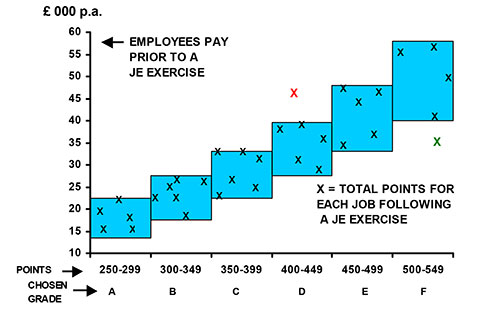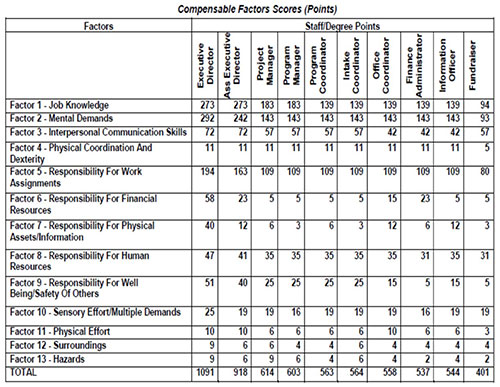The Important of Job Evaluation to Organizational Success
By Georges Gracieuse, CHRP
Does your organization have a system based on objective criteria to fix the pay levels? Is it based on the individual’s qualifications? Is it based on market price? If it is based on the individual’s qualifications, it may happen that the person is over-qualified for the job and is being over-paid. If it is based on market price, how can the organization know that the compared jobs are of equal value? Though the title of the two positions might be the same, the duties and responsibilities might be different.
Another issue is the criteria used to classify the jobs? Is the classification based on the titles or on the intrinsic worth of the job? If the classification is not perceived as being fair, it can create frustration and conflict.
These issues confronting many small businesses may be felt more acutely by yours, especially if you had been severely hit by the economic downturn of the recent years. You might have had to downsize and readjust the workflow and responsibilities of different jobs; or you might have merged and faced the challenges of integrating different pay levels for the same job performed. You might have found out that readymade job descriptions or salary surveys were inadequate to respond to the specific needs of your organization and that you needed tailor-made solutions.
Job evaluation could be such a solution for your business as it builds consistency and equity in your system through a process of job design, job description, job evaluation and pay structure. The aim of this comprehensive compensation analysis is to help you evaluate the relative value of the jobs to your organization and place them in appropriate pay grades.
The methods in use today have their roots in the work of Ned Hay, whose work (starting in the 1940s) is credited as “revolutionary” in the world of human resources. One of his key contributions to the workplace was the development of the first forms of job evaluation – the precursor to today’s Hay Group Guide Chart-Profilesm Method of Job Evaluation and the inspiration for most job evaluation approaches.
Benefits of a Comprehensive Compensation Analysis
A comprehensive compensation analysis provides you with strategic job and reward support as you re-structure your organization, giving you a robust foundation to build your success. The following are a few, but not exhaustive, benefits that your organization can derive from such an exercise:
- Job Design: Role clarity is a critical factor for individual efforts to contribute to company success. Today your dynamic small business needs an innovative approach to defining jobs, ensuring stability in an environment of constant change.
- Job Description: It is of particular importance for clarity of roles that your job descriptions contain all pertinent information necessary to reflect the assigned duties and responsibilities of the job and are aligned to your business objectives. These descriptions would serve as the basis from which to identify and classify the jobs for application of the pay scale.
- Job Evaluation: With the right jobs established, your organization can establish job value for classification and reward, ensuring consistent, fair and sustainable application.
- Pay Structure: Your competitive pay structure would reflect your organization’s internal equity and external benchmarking, essential to attraction and retention, given today’s talent challenges.
The Hay Group Guide Chart-Profiletm Method of Job Evaluation (or Hay Method)
The Hay Method is a proprietary job evaluation methodology that is the world’s most commonly used. It’s starts with understanding the organization and its jobs, and then breaking down a job and evaluate it on the basis of several compensable factors, which are further subdivided into degrees. At the end of the process, you arrive at points for each factor, and then add up the scores to give the overall job size.
The factors are based on some simple but powerful principles:
- Any job or role, in whatever organisational context, exists to provide some Contribution to the organisation in which it works – its Accountability
- Delivering this Accountability depends on Input of Knowledge, skills and experience – the Know-How
- Know-How must be applied and used in the Process of addressing the requirements of the job and solving the problems which arise in the job – the Problem Solving.
Any role can thus be characterised in terms of these three factors of Know-How, Problem Solving and Accountability and the relationship between them as illustrated in the following flow chart:

These three main factors are further sub-divided into a number of component elements about which individual judgements are made in order to arrive at an overall assessment of the job.
(The context (the Working Conditions) in which the job takes place is also considered, playing a particular role where pay equity is a concern or where either Working Conditions are significant or highly variable from job to job.)
The following are the elements within each of the core “job content” factors:
- Know-How
Within this factor there are three elements, namely:
- Depth and Scope of Practical/Technical Knowledge
This factor measures specialization and breadth of information and understanding necessary to perform the duties of the job. - Planning\, Organising and Integrating Knowledge
This factor measures the requirement in the job to plan, organise, supervise, co-ordinate and integrate different activities, resources, or parts of the organisation. - Communicating and Influencing Skills
This factor measures the requirement in the job to work with and through others in order to achieve necessary results.
- Problem Solving
This factor contains two elements as follows:
- Thinking Environment
This factor assesses the scope within the job to identify and address the problems which typically arise. Thinking environment depends on the absence or presence of policy, procedure, supervision and other guidance. - Thinking Challenge
This factor assesses the inherent nature of the problems which typically need to be dealt with, ranging from simple, repetitive problems at one extreme through to complex and novel situations at the other.
- Accountability
This factor deals with three elements, as follows:
- Freedom to Act
This factor defines the authority in the job to take decisions without referral to others or without additional constraints. - Magnitude
This factor indicates the area of the organisation or “magnitude” upon which the job impacts. - Type of Impact This factor establishes the strength or degree of impact the job has in relation to the chosen magnitude.
The purpose of the job evaluation is to enable you to establish pay levels for positions in a fair, consistent, orderly and equitable manner based on the worth of each job (Figure 1). What you evaluate is the position and not the employee occupying the position.
Fig 1: Developing a Graded Pay Structure

Note that the example above is not specific to the Hay Method – the points structure is given just as an example.
The Canadian Job Evaluation Method
While the Hay Method is in common use across Canada, there are other methods with wide adoption. One common and successfully implemented job evaluation system is based on thirteen compensable factors as illustrated in Table 1. (Like all job evaluation, it owes a debt to the original work of Ned Hay)
Table 1: Job Evaluation Factors (or Compensable Factors) used were:
- Job Knowledge
- Mental Demands
- Interpersonal Communication Skills
- Physical Coordination and Dexterity
- Responsibility for Work Assignments
- Responsibility for Financial Resources
- Responsibility for Physical Assets and Information
- Responsibility for Human Resources
- Responsibility for the Well Being and Safety of Others
- Sensory Effort and Multiple Demands
- Physical Effort
- Surroundings
- Hazards
A Case Study
What follows is an illustration to help you understand how this method works in a real life situation. It shows how it was used to evaluate the jobs in a small non-for-profit organization. The incumbents, using their Job Description as a guide, rated the factors of their jobs in the appropriate degree level. This rating was then reviewed by a job evaluation committee. The revised rating for each factor was converted into points, and then added up. The total indicated the value of the individual jobs (Table 2). The jobs were then classified into different pay grades based on their values (Table 3).
Table2: Compensation Factors Score

This exercise identified that staff in that organization fell into four broad categories based on the point factors, and it was recommended that the pay structure should reflect that fact as follows:
- Up to 429 pts: Pay Grade A
- 430 – 558 pts; Pay Grade B
- 559 – 687 pts: Pay Grade C
- 900 +: Executive Pay
The roles of the Executive Director and that of the Associate Executive Director were unique within the organization. No other post holder had the level of responsibility, experience or qualifications required to carry out these roles. It was recommended that these two positions fall into a separate pay banding: Executive Pay Grade (Table 3).
Table 3: Recommended Pay Structure

The type of comprehensive compensation analysis described in this article can help you organization build the human resources foundation needed for your success. The essence of this approach is customization: helping your organization identify the structural problems and proposing tailor-made solutions. The job evaluation aligns the individual jobs with your business strategies, enabling the incumbents to contribute in a more effective way to achieve your business objectives. This results in a more equitable classification. And finally a pay scale based on this internal equity and on benchmarking with comparable organizations would enable you to reward each individual more fairly.
Georges Gracieuse, MA-HRM, CHRP is a compensation specialist, facilitator and executive coach with Vital-HR in Vancouver.









